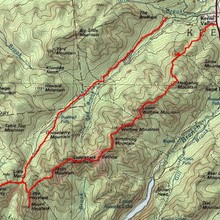The “crown jewel of FKTs in the Adirondacks” - Ryan Atkins
Description: Backpacker Magazine described the Great Range as follows:
There's no small irony in the fact that New York's tallest peak is merely the last challenge on this classic loop-and far from the toughest. The route scales nine peaks, including six 4,000-footers and the aforementioned 5,344-foot Mt. Marcy. But numerous cols and false summits, plus heinously eroded trail beds, wear you down physically and psychologically. From Keene Valley, the murderer's row of peaks includes Rooster Comb, Hedgehog, Lower Wolf Jaw, Upper Wolf Jaw, Armstrong, Gothics, Saddleback, Haystack, and Marcy, from which you descend the Phelps Trail. Gut-check moments include a half-mile of teetering above a 700-foot drop on a knife-edge between the Wolf Jaws - inevitably followed by a steep climb - and the southeast face of Gothics, a scary-steep, exposed descent over open slab rock. There are long stretches of scrambling and ladder-climbing, and you'll need to carry enough water for the day.
The Great Range Traverse boasts an elevation profile of nearly 500 ft/mile and is a tour of some of the highlight peaks in Adirondack Park. The route is extremely technical and has attracted some of the top trail athletes in the world. As a result, the Great Range is the top route in the Adirondacks.
Route Specifics: Runners are suggested to use the FKT GPX file for their route-finding. The route goes specifically from Rooster Comb Trailhead to the Garden Trailhead. Runners start their watch at the hiker register just across the footbridge from the Rooster Comb parking lot. First, Summit Upper Wolfjaw (20 yard out and back from the trail), then Summit highest point on Haystack, and Summit the summit block on Marcy (above the plaque). Follow the Phelps Trail on return (NOT the Hopkins trail), and runners must Stop their watches at the Garden Trailhead Parking lot.
Status: The Great Range Traverse is the #7 Northeast Regional FKT.
Support Style: The unsupported FKT is the traditional style for the route and has historically been more competitive than the supported.
Route History: Before Jan Wellford’s Great Range run, the idea of a Great Range Traverse existed, but there was no defined route. Jan’s track became the race route, and few routes have had more competition on them in the past 15 years. Ryan Atkins makes up a fair number of the FKTs on the men’s side, including battles with Lee Berube (a 4:09 miler) and Jack Kuenzle. These three athletes have each had their era of dominance in the northeast, but the Great Range is one of, if not the only route where such big names have converged (including Ben Nephew) in such quick succession. Perhaps what is most remarkable about the Great Range men’s record is that the FKT has improved only incrementally since 2009. From the beginning, the record would only ever be bested by a few minutes at a time. The women’s FKT has not had a similar number of FKTs set, despite several strong attempts over the last 5 years. While she disclaimed the strength of her run in her trip report, Lindsay Webster’s 2019 time still stands alone on many of the Strava segments along the Great Range.
Media Coverage: While the Great Range has been the subject of many blog posts, the FKT has not gotten notable media attention as of 6/2024.
Route Variations: The standard route is the regional premier route and is only run from Rooster Comb Trailhead to Garden Trailhead. The other variation can be found below.
- Ultra Tour du Great Range (created by Ben Nephew): A lollipop loop traversing the bulk of the Great Range both out and back. Run the standard Great Range route out to Marcy, skipping Haystack. Then run a short loop by summiting Skylight (via a brief out-and-back), and then climbing up the back of Haystack before on the Great Range. You can skip Rooster Comb on the way back. The difference in traversing the The objective here was to create a challenge in the Adirondacks similar to the Swan Song (NH), and the numbers are very similar (29 miles, 19,000 ft).
Rules for the route:
- follow the official trail at all times, use the official GPX for the routing
- the route goes specifically from Rooster Comb Trailhead to the Garden Trailhead, start your watch at register just across the footbridge from Roostercomb parking lot
- Summit Upper Wolfjaw (20 yard out and back from the trail)
- Summit highest point on Haystack and Summit the summit block on Marcy above the plaque
- Follow the Phelps Trail on return, NOT the Hopkins trail
- Stop watch at the Gardens Parking lot
The official route is as done by Wellford (see map/GPX) the route is about 25 miles with 9500 feet of elevation gain and 9000 feet of loss, starting at the Rooster Comb TH and ending at the Garden TH, both in Keene Valley. Backpacker Magazine called this the third hardest day hike in America, and described it thus:
There's no small irony in the fact that New York's tallest peak is merely the last challenge on this classic loop-and far from the toughest. The route scales nine peaks, including six 4,000-footers and the aforementioned 5,344-foot Mt. Marcy. But numerous cols and false summits, plus heinously eroded trail beds, wear you down physically and psychologically. From Keene Valley, the murderer's row of peaks includes Rooster Comb, Hedgehog, Lower Wolf Jaw, Upper Wolf Jaw, Armstrong, Gothics, Saddleback, Haystack, and Marcy, from which you descend the Phelps Trail. Gut-check moments include a half-mile of teetering above a 700-foot drop on a knife-edge between the Wolf Jaws - inevitably followed by a steep climb - and the southeast face of Gothics, a scary-steep, exposed descent over open slab rock. There are long stretches of scrambling and ladder-climbing, and you'll need to carry enough water for the day.
Ben Nephew proposed an "Ultra Tour du Great Range":
Great Range out to Marcy, skipping Haystack for later. Out and back to Skylight because it is an awesome peak, and then up the back of Haystack and back on the Great Range. You can skip Rooster Comb on the way back. The difference in traversing the Great Range depending on the direction is quite profound. The objective here was to create a challenge in the Adirondacks similar to the Swan Song, and the numbers are very similar. It's a long day out and wild ride. (about 29 miles, see Nephew's Strava for the track.)


Comments
I ran 5:17:03 today. I accidentally stopped my watch for 29 seconds heading up Saddleback, hence the difference in times (5:16:34 versus 5:17:03). Great weather! A little more mud from LWJ to Basin compared to last year. https://www.strava.com/activities/1797198916